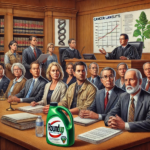The safety of talc, especially in personal care products like baby powder, has been a hotly debated topic. Concerns arise mainly from potential links to ovarian cancer and other health issues. Talc, a naturally occurring mineral composed primarily of magnesium, silicon, and oxygen, is used in various products for its moisture-absorbing properties. However, the potential for contamination with asbestos fibers, a known carcinogen, has raised alarms about its safety. Despite these concerns, it’s essential to understand the complexities and ongoing research around talc to fully grasp its risks, particularly in relation such a link to ovarian cancer and other health concerns.
Mass Tort America is dedicated to providing the latest information on product safety, and we understand the concerns you may have regarding talc. Our goal is to help you navigate these worries and offer guidance on potential legal actions if you’ve been affected. With a team of experienced attorneys, we are here to support you and provide the information you need to make informed decisions about your health and legal options.
Understanding Talc And Its Uses
Talc is a naturally occurring mineral that has been used for centuries in various applications. Its ability to absorb moisture and reduce friction makes it a popular ingredient in personal care products, such as baby powder, cosmetics, and deodorants. The cosmetic and pharmaceutical industries favor talc powder for its smooth texture and non-reactive properties. Talc is also found in industrial applications, where it is used to prevent caking in products like chewing gum.
The primary concern with talc arises from its natural formation, which often occurs in close proximity to asbestos deposits. Asbestos is a harmful substance known to cause lung cancer, mesothelioma, and other respiratory diseases. The potential for talc and other minerals to be contaminated with asbestos during mining has led to rigorous testing methods and regulations to ensure its safety in consumer products, including cosmetic talcum powder and commercial cosmetic talcum powder.
In the United States, the Food and Drug Administration (FDA) monitors the safety of talc in cosmetics. Despite these regulations, some studies have suggested a link between talc use and the risk of ovarian cancer, particularly when used in the genital area. This has resulted in numerous lawsuits and ongoing debates about the extent of the risk developed ovarian cancer associated with talc-containing products like Johnson’s Baby Powder.
Research And Health Risks
Scientific studies on the health risks of talc have produced mixed results. Some research indicates a possible association between talc use and an ovarian cancer risk, while other studies have found no significant connection. The International Agency for Research on Cancer (IARC) categorizes talc containing asbestos as possibly carcinogenic to humans, while the classification for asbestos-free talc remains a subject of debate. The National Cancer Institute and other health organizations continue to study these potential carcinogenic risks.
One of the primary challenges in assessing talc’s safety is the variability in study designs and methodologies. Case-control studies, which rely on participants’ recollection of talc use, may be subject to recall bias, potentially affecting the results. Conversely, cohort studies, which follow groups of individuals over time, have not consistently shown a significant increase in cancer risk. Researchers also study the effects of genital powder use and exposure and perineal genital powder exposure and use in postmenopausal women to understand the risk of ovarian cancer.
Despite these uncertainties, limited evidence of the potential for talc to cause harm has led to increased scrutiny and regulatory actions. Some companies have opted to reformulate their products or remove talc entirely to alleviate consumer concerns. It is crucial to stay informed about ongoing research and regulatory updates to make educated choices about talc-containing products, especially those used in cosmetic products and facial makeup.
Legal Actions And Consumer Protection
The potential health risks associated with talc have led to numerous lawsuits against manufacturers. Plaintiffs claim that companies failed to warn consumers about the dangers of talc, leading to significant legal battles. High-profile cases have resulted in substantial settlements and judgments, highlighting the importance of corporate responsibility and consumer research on cancer safety.
In response to these legal actions against consumer products, many manufacturers have made changes to their products and labeling practices. Some have transitioned to alternative ingredients, such as cornstarch, which offer similar benefits without the associated risks. Cornstarch-based powders are now commonly used as safer options in baby powders and other personal care products. These changes reflect a growing awareness of consumer concerns and a commitment to safety.
For consumers, understanding the legal landscape around talc is crucial. Being aware of your rights and the potential for compensation if you’ve been affected by talc-related health issues can empower you to take appropriate action. Legal representation can provide guidance and support, ensuring that your interests are protected.
The History Of Talc Use
The use of talc dates back to ancient times when it was prized for its softness and ability to absorb moisture. Historically, talc was used in various cultures for skincare, cosmetics, and even as a medicinal ingredient. Its application has evolved over the centuries, with modern uses spanning from industrial lubricants to personal hygiene products. The National Toxicology Program has also studied talc for its potential health impacts.
In the early 20th century, talc became a staple in baby powder, touted for its ability to prevent diaper rash and keep skin dry. This widespread use popularized talc, embedding it into everyday life. However, as scientific understanding of talc containing health risks improved, concerns about talc contamination and its potential link to cancer began to emerge. Researchers have focused on epithelial ovarian cancer risk and endometrial cancer risk associated with talc use.
The historical context of talc use is essential for understanding current debates. While its benefits are well-documented, the discovery of asbestos contamination in some talc deposits has shifted the focus to safety and regulation. This evolution underscores the need for continued vigilance and research into the materials we use daily. The American Cancer Society continues to update guidelines and provide information on talc-related health risks.
Talc And Asbestos: Understanding The Connection
The connection between talc and asbestos is a significant factor in the safety debate for talc miners. Asbestos, a group of naturally occurring minerals known for their durability and resistance to heat, is also a potent human carcinogen itself. When inhaled, asbestos fibers can cause serious diseases, including lung cancer and mesothelioma. Talc miners and workers in industries using talc are particularly at risk of occupational exposure.
Talc and asbestos can form under similar geological conditions, leading to the increased risk of cross-contamination during mining. Despite rigorous testing and regulations, instances of asbestos-contaminated talc have been reported. This contamination can occur naturally or during the processing and manufacturing of cosmetic grade talc-based body powder products. Testing methods have been developed to detect asbestos or asbestiform fibers in talc products.
Understanding the connection between talc and asbestos is crucial for assessing the risks associated with talc use. Regulatory agencies and manufacturers must ensure that talc products are free from asbestos contamination. Consumers should be aware of these risks and choose products from reputable brands that prioritize safety and transparency. Asbestos-free talc is a key focus for ensuring consumer safety.
Regulatory Efforts And Standards
To mitigate the risks associated with talc, regulatory agencies have established guidelines and testing standards. In the United States, the FDA oversees the safety of cosmetic products, including those containing talc. The FDA conducts regular testing and issues guidelines to ensure that talc used in cosmetics is asbestos-free. The National Institute for Occupational Safety and Health also monitors talc inhalation risks in industrial settings.
Internationally, other regulatory bodies, such as the European Medicines Agency (EMA) and Health Canada, have also implemented strict standards for talc. These organizations work to protect consumers by setting limits on asbestos content and requiring thorough testing of talc products before they reach the market. The World Health Organization also provides guidelines for safe talc use in various applications.
Despite these efforts, regulatory frameworks vary between countries, leading to inconsistencies in safety standards. Consumers should stay informed about the regulations in their regions and opt for products that meet the highest safety standards. Advocacy for stronger global regulations can help ensure the safety of talc products worldwide. Public health initiatives continue to address potential contamination and ensure product safety.
Alternatives To Talc In Personal Care Products
Given the concerns about talc, many consumers are turning to alternatives for personal care products. Cornstarch is a popular substitute, offering similar moisture-absorbing properties without the increased risk of asbestos contamination. It is commonly used in baby powders and body powders as a safer option. Other naturally occurring minerals are also being explored as potential talc alternatives.
Arrowroot powder is another alternative to talcum powder also gaining popularity. Derived from tropical plants, arrowroot powder is a natural and non-irritating ingredient used in various cosmetic and personal care products. Its fine texture and absorbent qualities make it an excellent replacement for talc. Manufacturers are increasingly incorporating arrowroot powder into their talcum powder formulations to meet consumer demand for safer products.
Silica microspheres are also used in cosmetics as a talc alternative. These tiny, round particles provide a silky feel and absorb oil effectively, making them ideal for products like setting powders and foundations. As consumer demand for safer options grows, more companies are exploring and incorporating these alternatives into their products. The use of titanium dioxide in cosmetics is another area of research and development.
Consumer Awareness And Advocacy
Raising consumer awareness about the potential risks of talc and advocating for safer products is vital. Educational campaigns and public health initiatives can inform consumers about the importance of use of talcum powder, checking product labels and choosing talc-free alternatives. Knowledge empowers consumers to make informed decisions about their health and safety. The National Cancer Institute provides resources and information on the potential risks of talc and use of talcum powder.
Advocacy groups play a crucial role in pushing for stricter regulations and corporate accountability. By highlighting cases of contamination and holding manufacturers responsible, these groups drive change and promote transparency. Their efforts ensure that companies prioritize consumer safety and adhere to rigorous testing standards. The American Cancer Society also supports research and advocacy efforts.
Consumers can also participate in advocacy by supporting legislation that enhances product safety standards and by choosing to buy from brands that prioritize transparency and health. Collective action and informed choices can lead to significant improvements in product safety and corporate practices. Public health advocacy continues to address the risks of occupational and environmental health issues related to talc exposure.
The Future Of Talc Use
The future of talc use in personal care products depends on ongoing research, regulatory actions, and consumer preferences. As more studies explore the health risks associated with talc, the scientific community and regulatory bodies must adapt their guidelines to reflect new findings. Continuous research is essential for understanding and mitigating any of cosmetic talc’ potential risks. The International Agency for Research on Cancer continues to evaluate cosmetic talc’s potential carcinogenic risks.
Manufacturers are increasingly responding to consumer demands for safer cosmetic products by reformulating their offerings and exploring alternative ingredients. This trend is likely to continue as awareness grows and more consumers seek talc-free options. The cosmetic industry must innovate and invest in research to develop safe and effective alternatives. The National Toxicology Program and other research organizations contribute to these efforts.
In the long term, the combined efforts of researchers, regulators, manufacturers, and consumers can lead to a safer marketplace. By prioritizing health and safety, we can ensure that personal care products are free from harmful contaminants and provide the benefits consumers expect without compromising their well-being. The use of pooled analysis and retrospective case-control studies will continue to inform safety standards.
What Should You Do If You’ve Used Talc Products?
If you have used talc products and are concerned about potential health risks, it is important to stay informed and proactive. Regular medical check-ups and discussing any concerns with your healthcare provider can help monitor your health. Early detection of any issues is crucial for effective treatment and management. The National Cancer Institute provides guidelines for monitoring health risks associated with talc use.
Staying updated on the latest research and regulatory developments regarding talc particles is also essential. By keeping informed, you can make educated decisions about your use of talc products and explore safer alternatives if necessary. Awareness of ongoing legal actions and settlements can provide insight into the broader implications of talc use. The American Cancer Society and other organizations offer resources on cancer risk and prevention.
If you believe you have been affected by talc-related health issues, seeking legal advice can help you understand your rights and options. Legal professionals can provide guidance on potential compensation and support you through the process of filing claims or lawsuits. Taking action can help protect your health and hold manufacturers accountable. Occupational and environmental health studies continue to shed light on the potential risks of talc exposure.
How Can Mass Tort America Help You?
At Mass Tort America, we understand the complexities surrounding talc safety and the impact it can have on your life. Our dedicated team of attorneys specializes in mass tort cases, ensuring that you receive the expert guidance and representation you deserve. We offer personalized support to navigate the legal process, from gathering evidence to negotiating settlements.
Choosing Mass Tort America means you benefit from our extensive experience and resources. We handle cases from across the nation, providing a concierge team to assist with coordination and communication. Our commitment is to help you achieve the best possible outcome, offering peace of mind and a path to justice. If you have concerns about talc and its potential impact on your health, contact Mass Tort America today at 800-356-4338 or visit our contact form at https://masstortamerica.com/contact/.



















